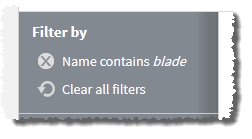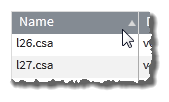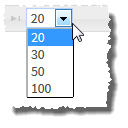Fields: Node Management
Path:
|
Image 7-2: Node Management |

|
|
Click to enlarge |
The Node Management page displays all nodes reported to Moab by your research manager. Here, you can obtain visibility into, and information about, your resources, including node states and feature tags. On this page, you can do the following:
- Assign a tenant to the selected nodes (see Assigning tenants to nodes).
- Place reservations on selected nodes (see Reserving Nodes).
- Search for, filter, and sort nodes (see Searching, sorting, and filtering nodes).
- Set feature tags on selected nodes (see Setting node feature tags).
- View detail information about a selected node (see Viewing node details).
Lets you narrow your search to a specific field
Search bar (contains)
Lets you specify a term to search in the field (for example, a term that would appear in a node Name). For more information, see Searching, sorting, and filtering nodes.
You should not use the ampersand (&) character in your search.
Filter by
Displays the filters applied to the nodes that appear in the list.
If you select a value from the Node State field, the filter is noted at the top of the Filter by section. Likewise, when you search on a specific field, the field value you selected appears in the section. For example, if you search by Name and enter "blade," the following appears:

To remove the filter on individual selected field values, click the remove icon ( ) next to the filter you want to remove. To remove all filters so that all nodes appear in the list, choose Clear all filters.
) next to the filter you want to remove. To remove all filters so that all nodes appear in the list, choose Clear all filters.
Tip: To save a set of filters and specific sorting order for easy reuse, bookmark the Node Management page in your browser once you finish creating your filters.
Lets you apply one of the following pre-determined state filter options to your list of nodes:
| Option | Description |
|---|---|
| Busy | Lets you apply a filter to the list that causes only the nodes in a "busy" state to display. "Busy" means that the node is running workload and cannot accept more. |
| Down | Lets you apply a filter to the list that causes only the nodes in a "down" state to display. "Down" means that the node is not available for workload. |
| Drained | Lets you apply a filter to the list that causes only the nodes in a "drained" state to display. "Drained" means that the node has been sent the drain request and has no workload on it. |
| Draining | Lets you apply a filter to the list that causes only the nodes in a "draining" state to display. "Draining" means that the node has been sent the drain request, but still has workload on it. |
| Flush | Lets you apply a filter to the list that causes only the nodes in a "flush" state to display. "Flush" means that the node is being reprovisioned. |
| Idle | Lets you apply a filter to the list that causes only the nodes in an "idle" state to display. "Idle" means that the node is available for workload, but is not currently running anything. |
| None | Lets you apply a filter to the list that causes only the nodes in a "none" state to display. "None" means that the node is set to "none" by the resource manager |
| Reserved | Lets you apply a filter to the list that causes only the nodes in a "reserved" state to display. "reserved" means that the node is being reserved. This is an internal Moab state. |
| Running | Lets you apply a filter to the list that causes only the nodes in a "running" state to display. "Running" means that the node is running workload and can accept more. |
| Unknown | Lets you apply a filter to the list that causes only the nodes in an "unknown" state to display. "Unknown" means that the state of the node is unknown. |
| Up | Lets you apply a filter to the list that causes only the nodes in an "up" state to display. "Up" means that the node is up, but the usage is being determined. |
List of nodes
Displays the nodes reported to Moab by your resource manager.
Nodes are attached to tenants. You will only be able to see nodes attached to tenants you belong to. For more information, see About tenant management.
The following fields are displayed in this list:
| Field | Description |
|---|---|
| Name | Displays the name of the node. |
| State |
Displays the state of the node. One of:
|
| Procs | Displays the number of processors on the node. |
| Memory | Displays the amount of memory (in megabytes) on the node. |
| Reservations |
Displays the reservation status of the node. One of:
|
| Features |
Displays a list of features present on the node. The Features column displays both reported features (features that are reported to Moab by a resource manager) and configurable features (or features that can be configured manually by a user or administrator through Viewpoint). Reported features display with a gray background, while configurable features display with a blue background. You can add or remove configurable features by selecting a node and clicking the Features option (for details, see Managing feature tags from the Node Management page). |
You can resize and reorder the columns in the table.
- To resize a column width, move your mouse to the center column border inside the column heading, then click and drag to where you want it to display.
- To change the column order, click the column heading for the column you want to move, then drag it to where you want it to display.
From the table, you can select a node to view its details (by clicking the Details button). You can also double-click a node to view its details. For more information, see Viewing node details.
Sort
Lets you sort the list of nodes by a particular field. Click the field once to sort in ascending alpha-numeric order. Click the field again to sort in descending order.

Page
Displays which page of results you are currently viewing (for example, "Page 3 of 14"). You can navigate between pages of nodes with the following options:
- Change the number of nodes that display on a page.
- Go directly to a page of results. (Specify the page number and hit the Enter button.)
- Navigate forwards and backwards through the pages, one at a time.
- Navigate directly to the first or last page of results.




Action buttons
Details
Lets you view the details of the node you have selected from the list. You can also double-click a node to view its details. For more information, see Viewing node details.
Make Reservation
Lets you select the node(s) on which to create a new reservation. You will be redirected to the New Reservation page where you can specify details for the reservation. See Creating a new reservation for more information.
Features
Lets add or remove configurable features on the node. For more information, see Setting node feature tags.
This option is grayed out until you have selected a node.
Assign tenant
Lets you assign the selected node(s) to a tenant. For more information, see Assigning tenants to nodes.
Refresh
Lets you refresh the list.
Related topics